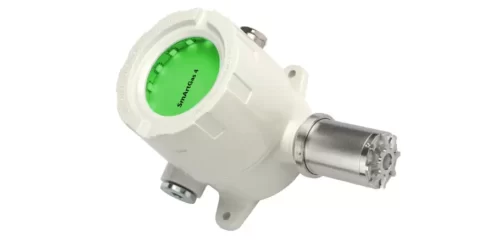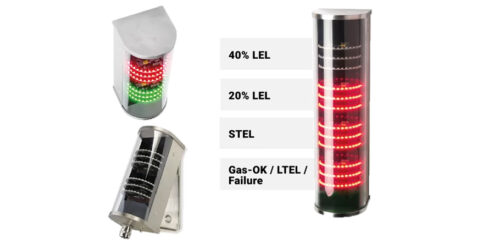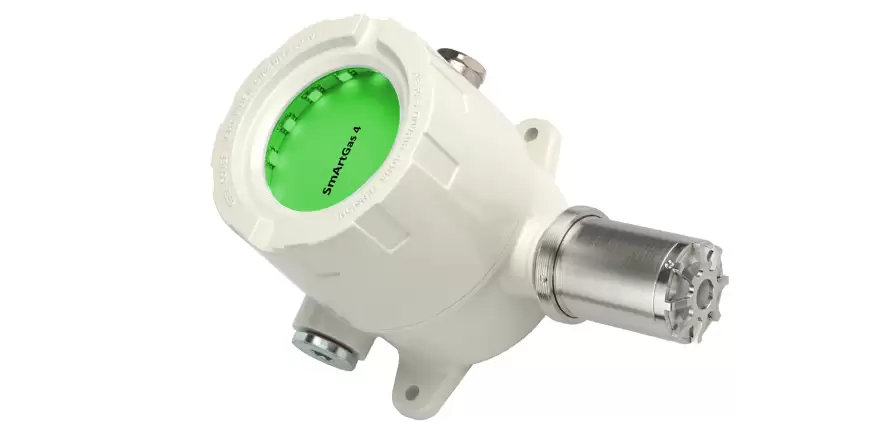Gas detectors: reliable, precise and fast measurement
(T90 reaction time of up to 13s for methane and up to 9s for hydrogen)
PLUS free configuration of alarm and warning condition, immediate notification of the threat to employees and simple integration into ventilation systems, for example,
with competitive purchasing conditions.
Gas detection systems are used wherever:
- dangerous concentrations of flammable gases may occur
- dangerous concentrations of toxic gases may occur
- oxygen can be displaced or absorbed by other gases.
The purpose of gas detection systems is the:
- detection and warning of incidents that may endanger human life and health,
- detection and warning of events that may result in high value losses,
- detection and warning of events that could lead to an industrial disaster,
- monitoring of systems containing hazardous media.

Reliable and configurable gas safety system
Functionality and safety level of standard gas detection systems
Innovative heads in terms of measurement speed, unique R-G-OFF optical warning system
Easy integration of the control panel into other systems such as ventilation
How does it work in practice?
We will design the system individually according to your needs
An added value is the all-in ATEX and fire protection offer.
The entire system is controlled by a single/multi-zone control station
Transmission of information to external systems, e.g. SCADA; relay outputs to other devices
Multiple alarm zones; up to 32 sensors on each bus
Premium gas detectors at the price of standard detectors
Wide range of ATEX-certified equipment
Unique alarm function GAS OK (R-G-OFF)

In what areas of an industrial plant should gas detectors be fitted?

Check out our gas detection range
Detectors for all applications in the energy industry, refining, food industry, gas compressor stations and anywhere there is a risk of hazardous gases escaping.

SmArtGas 4 detector
The SmArtGas 4 gas sensor has been developed to provide reliable gas measurement, monitoring and detection in harsh environments. Designed in accordance with the ATEX Directive, it is intended to operate within explosive atmospheres, which also allows it to function in other harsh environmental conditions, such as when there are high temperatures, vapours, moisture or dust around.
ProGas 4 detector
The ProGas 4 sensor is a device that, despite its industrial nature, cannot be used in hazardous areas. This has its advantages, as it allows it to use the widest possible range of sensors to detect, for example, sulphur hexafluoride used in the energy industry and RX gases.
ReAct 4 detector
The ReAct 4 gas sensor has been developed to measure concentration of reactive gases when an Ex device is required, including aggressive and corrosive atmospheres.
RapidGas E aspiration detector
The RapidGas E aspiration sensor is used for measurement in places that are difficult to access, dangerous to humans (e.g. a generator in a power station, generator connections), or when the gas being measured has a high temperature, humidity. Designed in accordance with the ATEX Directive, it is intended for use within explosive atmospheres.
RapidGas S aspiration detector
The RapidGas S aspiration sensor is used for measurement in places that are difficult to access, dangerous to humans (e.g. a generator in a power station, generator connections), or when the gas being measured has a high temperature, humidity.
LTT2 and LTT4 optical/sound signalling device
The LTT2 or LTT4 optical/sound signalling devices provide comfort and a sense of security for workers in spaces within which SmArtGas 4, ProGas 4 or ReAct 4 detectors are used. Due to their ATEX certification, they can be used in hazardous areas.
Sigma Control L control unit
The Sigma Control L control unit supports between 1 and 20 sensors (depending on type) SmArtGas 4, ProGas 4 or ReAct 4. It is designed to indicate the conditions of the sensors connected to the system, and this information is presented on the display and on the built-in System Optical Indicator
how to select detector models and sensor types?
Gas sensors as part of a safety system
It is important to remember that gas detectors are not a stand-alone safety system. Their purpose is to monitor the concentration of hazardous gases at selected critical locations. If the warning and alarm conditions are exceeded, the detectors must notify the facility staff via the control unit and the danger that has occurred. They activate not only the alarms in the IT systems, but also the connected sound and optical alarms, so that people in at-risk areas are immediately aware of the need to stop work. Of course, the control panel can send signals to, for example, the ventilation system to switch it on or increase its capacity, however, for the actual removal of the hazard (e.g. leakage) often requires the participation of maintenance staff to diagnose the exact location of the failure and remove the fault.
How to design an efficient gas detection system?
1. Risk assessment on the need for gas detector
Carry out a risk assessment for your plant or system for the risk of hazardous gases escaping and their effects on the health of workers, and the risk of further hazardous events occurring – e.g. explosive atmosphere formation in certain areas. This assessment will allow you to determine the locations of the gas detectors.

2. Visualisation of potential gas leakage points and possible ignition sources
Such visualisation, e.g. in the form of a drawing or diagram, is in a way a transfer of the completed risk assessment into a form that can be quickly looked through to realise the current situation on site. It is useful to include three main categories of areas on it:
- Potential leakage points – examples include valves, utility distribution systems or terminal connections
- Spill impact areas – these are the locations through and into which the released gases will travel. Here, it is always important to pay attention to the physical properties of the specific gases, as these will determine how they will behave when a leak occurs. On the visualisation of the plant or system, it is then useful to mark those areas which will pose a risk to the health of workers or a risk of damage to the infrastructure, e.g. due to the corrosive properties of a particular substance. Examples of such places include, for example, areas with lowered ceilings or limited space in general, as well as any ducts, staircases, emergency passages, etc.
- Potential areas where gas concentrations may occur at values that could cause a fire or explosion if they come into contact with an ignition source – these are areas where you find that there is a real possibility of an explosive atmosphere coming into contact with an ignition source
3. Location of gas detectors
When selecting the locations for the gas detectors, it is important to consider
- Any areas where the highest concentrations of gas are likely to occur such as corners, cavities, etc. areas with lower ceilings or other densely built-up areas. Take into account the density of the gas relative to the air to properly determine the appropriate mounting height of the sensors for a particular gas.
- Potential leakage sites, as it is useful to test gas concentrations as close as possible to such sites
- Explosive properties of the gases, and if they exhibit such properties, be sure to place a gas sensor between the area of the potential leak and the area of possible contact of the explosive atmosphere with the ignition source
- Toxic properties of the gases or the need to measure oxygen deficiency in areas with many potentially exposed workers. As with explosive properties, gas detectors should be placed between the potential source of the leak and the area of danger.
- Existence of humidity and dust at the gas detector installation site. Adverse conditions can affect the correct operation of the sensor. If it is necessary to use a detector in this type of location, it is important to use those whose design ensures interference-free operation and no danger to the sensor.
In order not to distort the measurement values, do not place gas detectors:
- in the vicinity of fresh air ducts such as entrances, vents, as the gas concentration is likely to be diluted in such areas
- in the vicinity of radio transmitters and sources of interference (EMI/RFI), which may be, for example, welding machines or induction heaters
Furthermore, for areas where there may be various particles in the air that can deposit on the sensor, it is essential to use a detector with a properly protected sensor. Examples of such areas include printing or paint shops.























![[Case study] Dust cloud ignition caused by static electricity](https://www.grupa-wolff.com/wp-content/uploads/2018/04/case-study-dust-cloud-ignition-caused-by-static-electricity.jpg)

